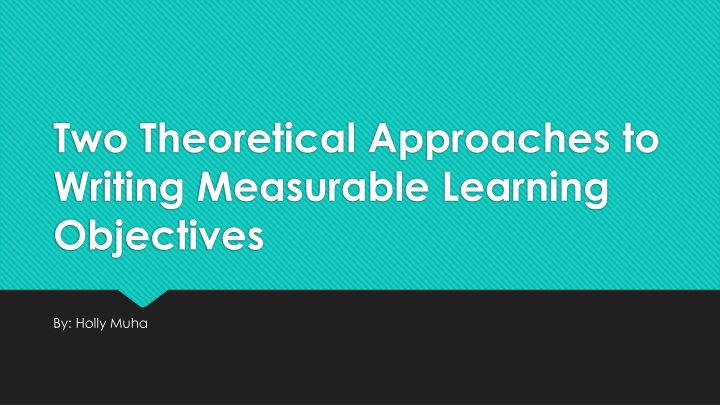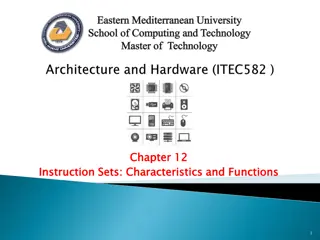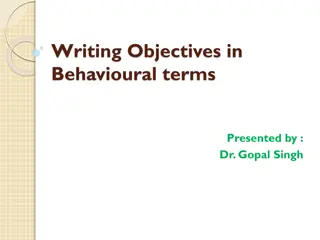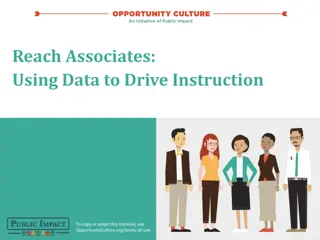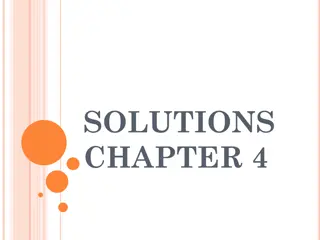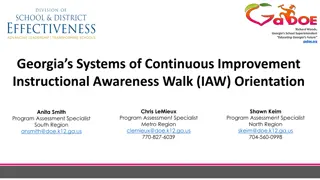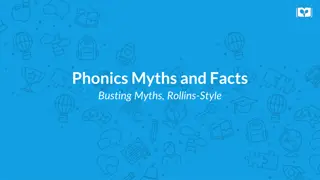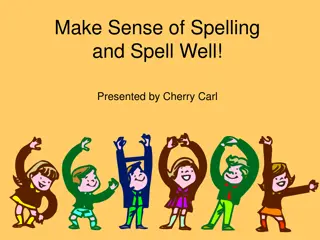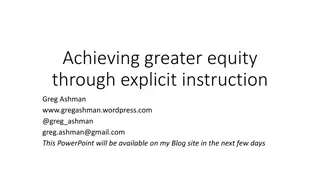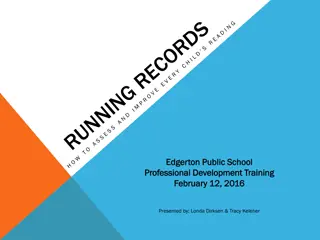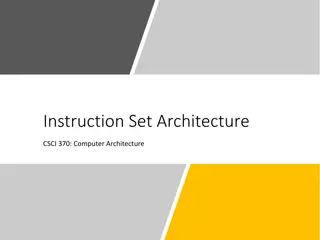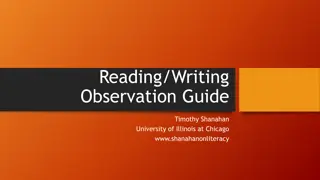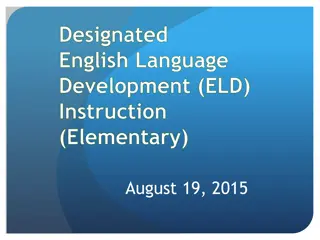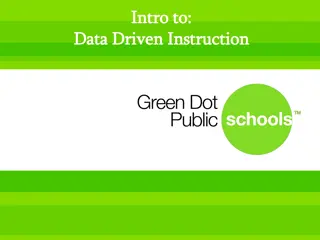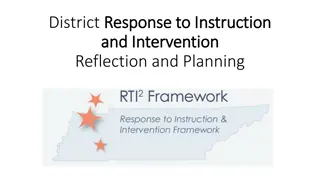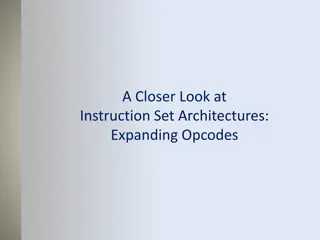Enhancing Learning Objectives for Effective Instruction
Learning objectives play a crucial role in student achievement, particularly in online courses. Measurable objectives provide clarity and focus, guiding learners towards specific outcomes. Understanding the differences between goals and objectives, as well as following guidelines such as Mager's criteria, can help in developing clear and effective learning objectives that support educational goals.
Download Presentation

Please find below an Image/Link to download the presentation.
The content on the website is provided AS IS for your information and personal use only. It may not be sold, licensed, or shared on other websites without obtaining consent from the author.If you encounter any issues during the download, it is possible that the publisher has removed the file from their server.
You are allowed to download the files provided on this website for personal or commercial use, subject to the condition that they are used lawfully. All files are the property of their respective owners.
The content on the website is provided AS IS for your information and personal use only. It may not be sold, licensed, or shared on other websites without obtaining consent from the author.
E N D
Presentation Transcript
Two Theoretical Approaches to Writing Measurable Learning Objectives By: Holly Muha
Valuable part of the students' learning experience. Especially critical to the development of online courses, where instruction is broken into technology-mediated forms of presentation, activity and assessment. \ Contents of online courses, or learning objects, should directly relate to the stated learning objectives. Informing students of what is expected of them can help student achievement, and provide opportunities for assessment. Learning objectives can help students read dense texts and focus on the essential learning concepts. Why should we care about measurable objectives? If you do not tell learners what they will be expected to do, then they are left guessing what you want.
Goals vs. Objectives Objectives are: Goals are: narrow / specific concrete, easy to measure / assess usually set for a short term broad / general intentions or directions abstract, hard to measure usually have a longer time frame Learning Objectives to support the goal: Examples of Goals: Students will understand the United States legal system and lawyers' principal roles in that system. Students will learn about the development of the common law Students will read about the basics of U.S. legal culture: U.S. Constitution, U.S. legal institutions, and federalism. By the end of this course, students will be able to: Explain how to use cases to construct legal arguments Predict the probable judicial resolution of simulated legal disputes Describe the nature and sources of ethical standards of the legal profession
Mager was one of the founders of the International Society for Performance Improvement in 1962. His first book, published in 1962, Preparing Objectives for Programmed Instruction is one of the most widely-read books written on the topic. He is also known for his work on writing performance-based learning objectives using Bloom s. He is one of the 10 most-cited authors in the field of instructional design. Who is Dr. Robert Mager?
Magers Guidelines Performance Criterion Condition
A performance may address: the cognitive domain (thinking abilities) affective domain (emotions, feelings, and choices) Performance psychomotor domain (physical movements). Reflection Do your objectives have a clear performance? Performance informs what learners will be able to do specifically at the end of instruction. Does each performance use a concrete, action-oriented verb? Does it use a vague verb such as: learn, understand, know, etc.? Does it have a clear, focused object?
A criterion adds a standard for evaluation to make performance even more measurable. If not achieved, remediation is needed. Students who perform below the standard may not acquire essential skills they need for the next (higher) learning. This could lead to further confusion and frustration when these skills have not been mastered properly. Criterion Reflection Criterion is a performance standard specified by the instructor or program. Do your objectives include a criterion or criteria? If students do not meet the criterion, what would be your remediation plan to help them achieve the mastery?
One reason for specifying a condition is that it is difficult to assess performance in ALL conditions (or multiple conditions and contexts) because of the limited instructional time and resources. Therefore, we choose one ideal condition to assess performance. If it is a success, the instructor may assume that students are able to perform a similar task in other conditions or to perform a slightly different task. The instructor should provide students with opportunities to apply learning in different situations and contexts to increase learning transfer. Condition Condition describes a situation or condition under which performance occurs or which students perform the tasks. Reflection Do your objectives include a condition? Do your objectives include a condition? Do you allow applying learning in different contexts?
In Practice Audience: Who are your learners (who will be doing the performance)? Behavior: Describe the task or behavior using action verbs -- be sure it is something that can be heard or something that is observable. Conditions: Under what conditions (what tools, aids or reference materials can the learner use? Are there things that they won't be able to use?) Degree: To what degree of mastery -- how well must it be done (speed, accuracy, quality, etc.)?
Robert Gagne The father of instructional design developed: The conditions of learning The 9 Events of Instruction Steps of Planning Instruction Evaluation of Instruction
Gagnes Guidelines Situation Outcome verb Object Action verb Tools & constraints
Comparison between Mager and Gagne Mager Condition Performance Criterion Gagne Situation Outcome Verb Object Action Verb Tools and Constraints Example 1 Given a list of 10 items to be memorized adopts the keyword mnemonic technique for memorizing the list using no mechanical aids, within 30 seconds without references Example 2 Given a verbal question states three causes of the Civil War orally or in writing
Does the learning objective support the course goal? Does the learning objective target a specific performance? Review your objectives Is the learning objective student-centered? Does the learning objective utilize an action verb with a focused object? Does the learning objective specify a criterion to measure its achievement? Does the learning objective specify a performance condition? Please use this checklist to review your learning objectives Does the learning objective reflect a behavior that is easily observable? Does the learning objective match an instructional activity and assessment?
References Gagne, R. M., Briggs, L. J., & Wager, W. M. (1992). Principles of instructional design (4th ed.). Orlando, FL: Harcourt Brace Jovanovich. (Pages 130-135) Mager, R. F. (1984). Preparing instructional objectives (2nd ed.). Belmont, CA: Lake Publishing. Mager, R. F. (1968). Developing attitude toward learning. Mager, R. F. (1962). Preparing instructional objectives.
